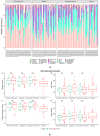Microbiome diversity in African American, European American, and Egyptian colorectal cancer patients
- PMID: 37483698
- PMCID: PMC10362239
- DOI: 10.1016/j.heliyon.2023.e18035
Microbiome diversity in African American, European American, and Egyptian colorectal cancer patients
Abstract
Purpose: Although there is an established role for microbiome dysbiosis in the pathobiology of colorectal cancer (CRC), CRC patients of various race/ethnicities demonstrate distinct clinical behaviors. Thus, we investigated microbiome dysbiosis in Egyptian, African American (AA), and European American (EA) CRC patients.
Patients and methods: CRCs and their corresponding normal tissues from Egyptian (n = 17) patients of the Alexandria University Hospital, Egypt, and tissues from AA (n = 18) and EA (n = 19) patients at the University of Alabama at Birmingham were collected. DNA was isolated from frozen tissues, and the microbiome composition was analyzed by 16S rRNA sequencing. Differential microbial abundance, diversity, and metabolic pathways were identified using linear discriminant analysis (LDA) effect size analyses. Additionally, we compared these profiles with our previously published microbiome data derived from Kenyan CRC patients.
Results: Differential microbiome analysis of CRCs across all racial/ethnic groups showed dysbiosis. There were high abundances of Herbaspirillum and Staphylococcus in CRCs of Egyptians, Leptotrichia in CRCs of AAs, Flexspiria and Streptococcus in CRCs of EAs, and Akkermansia muciniphila and Prevotella nigrescens in CRCs of Kenyans (LDA score >4, adj. p-value <0.05). Functional analyses showed distinct microbial metabolic pathways in CRCs compared to normal tissues within the racial/ethnic groups. Egyptian CRCs, compared to normal tissues, showed lower l-methionine biosynthesis and higher galactose degradation pathways.
Conclusions: Our findings showed altered mucosa-associated microbiome profiles of CRCs and their metabolic pathways across racial/ethnic groups. These findings provide a basis for future studies to link racial/ethnic microbiome differences with distinct clinical behaviors in CRC.
Keywords: African American; Colorectal cancer; Egyptian; European American; Microbiome.
© 2023 Published by Elsevier Ltd.
Conflict of interest statement
The authors declare that they have no known competing financial interests or personal relationships that could have appeared to influence the work reported in this paper.
Figures





References
-
- Ferlay J., et al. Cancer incidence and mortality worldwide: sources, methods and major patterns in GLOBOCAN 2012. Int. J. Cancer. 2015;136(5):E359–E386. - PubMed
-
- Siegel R.L., et al. Colorectal cancer statistics, 2020. Ca - Cancer J. Clin. 2020;70(3):145–164. - PubMed
-
- Beaugerie L., Itzkowitz S.H. Cancers complicating inflammatory bowel disease. N. Engl. J. Med. 2015;372(15):1441–1452. - PubMed
Grants and funding
LinkOut - more resources
Full Text Sources

